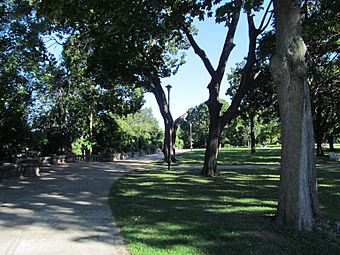Pulaski Park (Holyoke, Massachusetts) facts for kids
Quick facts for kids |
|
|
Prospect Park
|
|

Pulaski Park
|
|
| Location | Holyoke, Massachusetts |
|---|---|
| Built | 1884 |
| Architect | John Tighe |
| NRHP reference No. | 04000931 |
| Added to NRHP | September 10, 2004 |
Pulaski Park is a cool city park located right next to the Connecticut River in Holyoke, Massachusetts. It was first called Prospect Park when it was created in 1884. Later, in 1939, it got its current name to honor Casimir Pulaski. He was a hero from the American Revolutionary War, and there's a special memorial for him in the park. The famous Olmsted Brothers landscape design firm helped plan the park, which was originally about 5.1 acres big.
Discover Pulaski Park's Features
This park has some neat things to see and do. The northern side of the park follows the curve of the Connecticut River. There's a long concrete wall along the riverbank, built between 1905 and 1910. This wall has small piers every ten feet and four spots where you can look out over the water.
A concrete walkway runs right next to the wall. It's a great place to walk and enjoy views of the river. In the middle of the park, there's a small garden. It's surrounded by a fancy metal fence. Inside the garden, you'll find a large rock with a bronze plaque. This plaque remembers Casimir Pulaski. The main part of the park was added to the National Register of Historic Places in 2004. This means it's an important historical site.
The Story of Pulaski Park
When the city of Holyoke was first planned in the 1840s, this area wasn't set aside for a park. It was known as "The Patch." Many Irish immigrant workers lived there in small shacks. They were building the city's canals and other important structures.
Later, between 1865 and 1884, the shacks were cleared away. People started using the area as an informal park. Many Irish residents called it "Kerry Park." This was a nod to County Kerry in Ireland and the green views the park offered.
In 1884, the Holyoke Water Power Company owned the land. They gave it to the city, and that's when it officially became Prospect Park. From 1884 to 1898, paths were built, and plants were added. Some things from that time, like a bandstand, are no longer there. A wooden fence used to line the park along the river.
In 1901, John C. Olmsted suggested building a stronger wall along the river. This led to the concrete wall you see today. He also recommended making the park look even better with new plants.
By the mid-1900s, many Polish families lived near the park. On May 7, 1939, the park was renamed after Casimir Pulaski. There was a big celebration with a parade and over 500 people. They came from local Polish community groups. City and state officials were there, along with a representative from the Polish Consulate in New York City.
A historian from Holyoke, Edward Pinkowski, later found Pulaski's forgotten burial site. This happened in Savannah, Georgia, in 1996.
During the 1960s, the area south of the park was updated. Some streets were changed, and Prospect Street was removed. Now, only Maple Street connects the park to the main street grid.



